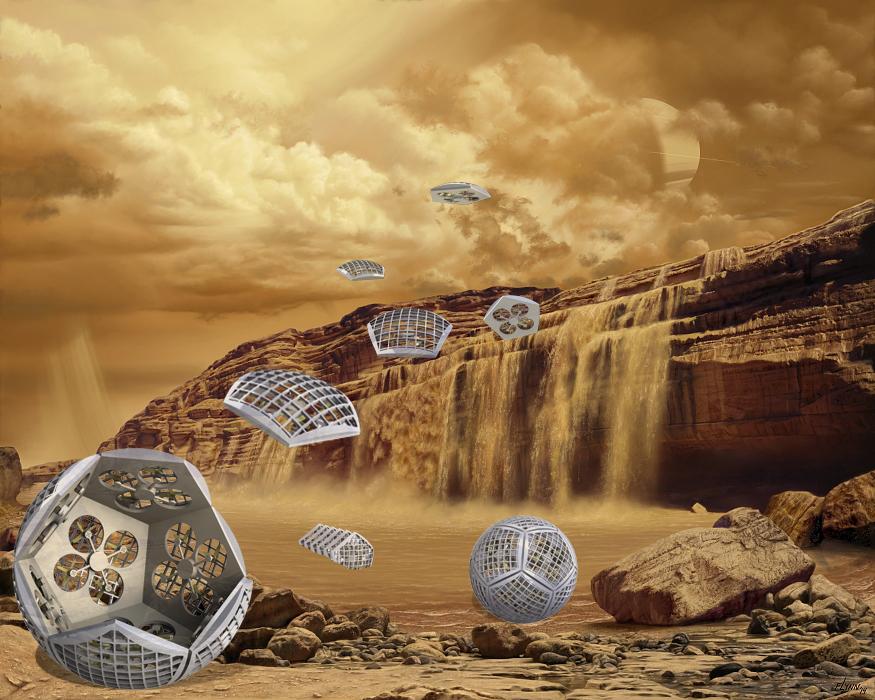Shapeshifter Robots Could Explore Volcanoes and Caves on Saturn's Moon Titan
Astounding robots straight out of science fiction could reimagine Titan exploration.
New shapeshifting robots could give us access to distant worlds like never before — including the soupy moon Titan in Saturn's neighborhood.
NASA's Shapeshifter concept promises mini-robots capable of rolling, flying, floating and swimming all in one type of machine. Engineers are testing out the concept in a robotics yard at NASA's Jet Propulsion Laboratory (JPL) in California.
NASA describes the prototype as "a contraption that looks like a drone encased in an elongated hamster wheel," but that's fine, since this robot isn't trying to look glamorous. Instead, the point is that it can split into two half-wheels, each of which is an independent drone armed with a propeller. Eventually, JPL envisions these robots working in teams of a dozen that do much more than just fly and roll.
Related: Saturn's Moon Titan May Have 'Phantom Lakes' and Caves
Shapeshifter's vision is that several autonomous robots — called "cobots" — can self-assemble into larger contraptions. As necessary, the cobots (which are each equipped with a small propeller) can move independently or together as mission requirements demand. Their functions could include swimming, spelunking (cave exploring), flying or rolling along the surface in a sphere-like shape.
Shapeshifter is one of several projects funded by the NASA Innovative Advanced Concepts program, which is meant to test far-out ideas that could be useful for space exploration in a few decades. While the robotic units could be deployed to several solar system destinations, Principal Investigator Ali Agha of JPL considers Saturn's moon Titan an ideal destination, according to a NASA statement.
Titan has seen only one probe land on its surface — the European Huygens probe, which hitched a ride with the epic NASA-European Space Agency Cassini orbital mission. Huygen's brief operations in 2005, coupled with Cassini's long-term observations between 2004 and 2017, showed Titan is a world much like Earth in surprising ways. Underneath a thick haze of orange cloud, Titan has a liquid cycle like our own planet — but with one key difference. Instead of liquid water, the rain, lakes and rivers are flowing methane and ethane.
Breaking space news, the latest updates on rocket launches, skywatching events and more!
There's still much scientists want to learn about Titan, including research questions best answered by more surface craft. For example: Some researchers suspect there might be icy volcanoes on the surface, erupting with ammonia or water instead of magma. Perhaps there are also caves that were too small for Cassini to see during its periodic flybys of the moon.
"We have very limited information about the composition of the surface. Rocky terrain, methane lakes, cryovolcanoes — we potentially have all of these, but we don't know for certain," Agha said in the statement. "So we thought about how to create a system that is versatile and capable of traversing different types of terrain, but also compact enough to launch on a rocket."
Agha suggested that some future mission could carry a "mothercraft" to the surface of Titan, which would power the cobots and carry additional scientific instruments to do its own work. The cobots might even work together to move this lander from place to place.
According to Agha, 10 cobots could carry a lander the size of Huygens (which was 9 feet, or 3 meters, across) and fly it to different locations. The cobots would get a big assist from Titan's environment, which has a lower gravity and denser atmosphere than Earth's, making it an ideal world for aerial transport as the cobots discover fascinating new areas to explore.
"It is often the case that some of the hardest places to get to are the most scientifically interesting because maybe they're the youngest, or they're in an area that was not well characterized from orbit," Jason Hofgartner, JPL's lead scientist for Shapeshifter, said in the same statement. "Shapeshifter's remarkable versatility enables access to all of these scientifically compelling places."
The Shapeshifter team plans to request more funding through the NIAC Phase II selection process in 2020. While this team prepares for the new funding round, however, NASA is already hard at work on a rotorcraft lander for Titan. The mission, a life-hunting drone called Dragonfly, is scheduled for launch in 2026.
- Landing on Titan: Pictures from Huygens Probe on Saturn Moon
- Propelling Exploration: Drones Are Going Interplanetary
- Amazing Photos: Titan, Saturn's Largest Moon
Follow Elizabeth Howell on Twitter @howellspace. Follow us on Twitter @Spacedotcom and on Facebook


Elizabeth Howell (she/her), Ph.D., was a staff writer in the spaceflight channel between 2022 and 2024 specializing in Canadian space news. She was contributing writer for Space.com for 10 years from 2012 to 2024. Elizabeth's reporting includes multiple exclusives with the White House, leading world coverage about a lost-and-found space tomato on the International Space Station, witnessing five human spaceflight launches on two continents, flying parabolic, working inside a spacesuit, and participating in a simulated Mars mission. Her latest book, "Why Am I Taller?" (ECW Press, 2022) is co-written with astronaut Dave Williams.


